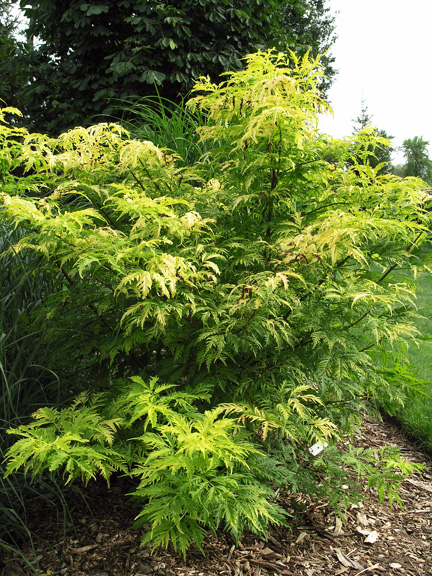| General Description | A medium to large shrub with attractive flowers and fruit. |
| ID Characteristic | Numerous branches, easily broken with yellow-white flowers in pyramidal clusters followed by red berries. Leaves are pinnately compound, leaflets often uneven at base. Crushed leaves have unpleasant smell. |
| Shape | Erect, much branching shrub, clump forming. |
| Landscape | Naturalized areas, informal hedges, massing. Berries are attractive to birds. Some Cultivars- ‘Pulmosa Aurea’ and ‘Tenuifolia’ are grown for their appealing foliage. |
| Propagation | Softwood cuttings in summer or hardwood cuttings in autumn that are planted in a sheltered border until spring then moved to a permanent location. |
| Cultivation | Grows in most conditions, but can look untidy in winter. An accent to a naturalized setting. |
| Pests | Elder borer: Wing covers orange at base and iridescent steel blue at tips. Long jointed antennae look like horns. Bores into stems. Also potential for powdery mildew, canker and leaf spot. |
| Habitat | Open woods, sub-alpine meadows, clay to sandy upland sites, wet organic sites. |
| Bark/Stem Description | Newer branches yellowish-brown and smooth, maturing to greyish-brown, thick and warty. |
| Flower/Leaf Bud Description | Spring buds in opposite arrangement. |
| Leaf Description | Pinnately compound with 5-7 leaflets, ovate, pointed at tip, often uneven at base. 5-13 cm long, 2.5-5 cm wide. Upper surface green and smooth, underside pale and hairy. Margins sharply toothed. Petioles 2.5-5 cm long. Crushed leaves give off an unpleasant odour. |
| Flower Description | Yellow-white, 3-6 mm wide with 5 petals. Numerous in elongated pyramidal panicles 5-13 cm long. April- June depending on zone. |
| Fruit Description | Red and berry-like, 4-6 mm long. Smooth, 3 seeded. Grow in upright clusters. Contain a purgative alkaloid, Sambucine. Berries must be seeded and cooked to be edible, otherwise toxic to humans. Enjoyed by birds. |
| Colour Description | Green leaves. Yellow-white flowers in spring, Red fruit in Summer. Golden foliage in autumn. |
| Texture Description | Brittle stems, warty when mature. |
